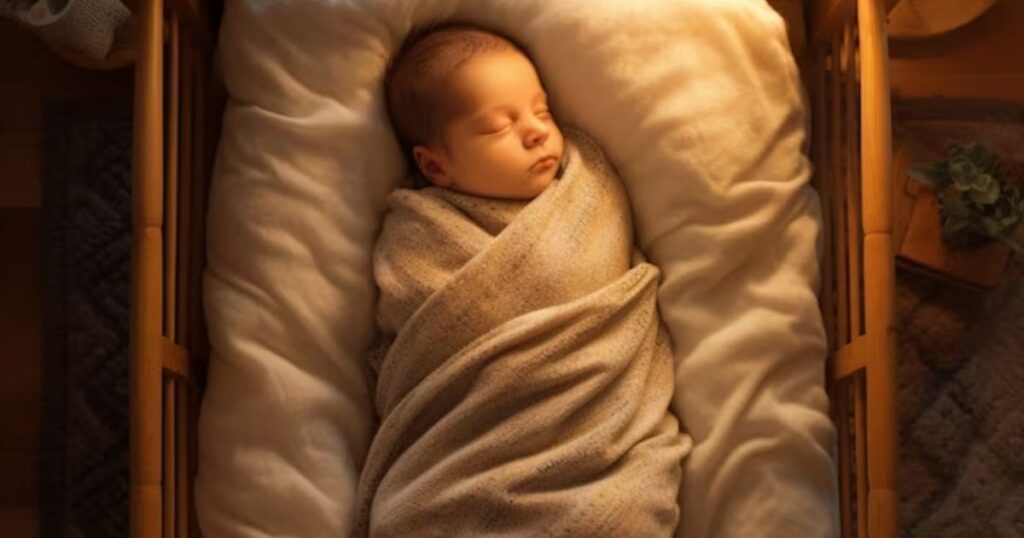Teaching your 5-month-old baby to sleep better is about making a regular bedtime routine and helping them learn good sleep habits. At this age, babies are figuring out their own sleep patterns, and sleep training can help them sleep longer and more peacefully.
Wondering how to sleep train your 5-month-old? It’s a bit of a challenge, but it can be really good for both you and your baby. As your little one starts to explore the world, helping them sleep well becomes important. You just need to find the right way that suits your baby, and with some patience, you can help them sleep better.
When it comes to teaching a 5-month-old to sleep, it’s important to understand your baby’s growth and what they need. Having a regular routine not only helps your baby’s body but also their brain and feelings.
What sleep training is?
Sleep training is about helping your baby learn how to sleep better. It’s like teaching them the skills to fall asleep on their own and stay asleep for longer periods. It is as guiding your little one to have a routine at bedtime so that they feel comfortable and secure when it’s time to sleep.
In simple terms, sleep training is a way to help your baby develop healthy sleep habits. It involves creating a bedtime routine, like giving them a warm bath or reading a short story. The goal is to teach your baby to soothe themselves and feel calm when it’s bedtime, so they can sleep more peacefully, and you can have a better night’s rest too. It’s a gentle process that varies based on your baby’s needs and your parenting style.
Time to start sleep training

Deciding when to start sleep training depends on your baby’s individual needs and development. Most experts suggest that you can begin sleep training 11 month old when your baby is around 4 to 6 months old. At this age, babies often have more regular sleep patterns and can learn to self-soothe.
Before starting sleep training, it’s essential to ensure that your baby’s basic needs are met. They should be healthy, not hungry, and their diaper should be clean. It’s also a good idea to establish a consistent bedtime routine to signal to your baby that it’s time to sleep.
Remember, every baby is different, and there’s no one-size-fits-all approach to sleep training. Pay attention to your baby’s cues and be patient as you introduce new sleep routines. If you have concerns or questions, it’s always a good idea to consult with your pediatrician for guidance tailored to your baby’s specific circumstances.
Methods of Sleep training

Sleep training methods are different ways parents use to help their babies learn how to sleep independently and develop better sleep habits. There are various approaches, and the one that works best may depend on your baby’s temperament and your parenting style. Here are some common sleep training methods:
Ferber Method (Gradual Extinction)
This method involves putting your baby to bed while they are still awake and then letting them cry for short, predetermined intervals before offering comfort. The waiting periods gradually increase over time. The idea is that, with practice, your baby learns to self-soothe and fall asleep without needing you to intervene immediately.
Chair Method
This approach involves placing a chair next to your baby’s crib during bedtime. Initially, you sit close to them, providing comfort without picking them up. As nights progress, you move the chair farther away until you’re eventually outside the room. The gradual distance increase helps your baby adjust to falling asleep independently.
No Tears Method
Also known as the “gentle” approach, this method involves responding to your baby’s cries promptly but without immediately picking them up. You offer comfort and reassurance in a gradual manner, helping them learn to self-soothe over time. This method emphasizes a more patient and slow transition to independent sleep.
Cry It Out
The Cry It Out method involves putting your baby to bed and letting them cry for progressively longer intervals before going in to comfort them. The waiting periods become longer each night, and the goal is for your baby to learn self-soothing techniques and eventually fall asleep without relying on you for immediate comfort.
Chair Method
This method involves placing a chair next to your baby’s crib during bedtime. Initially, you sit close to them, providing comfort without picking them up. As nights progress, you move the chair farther away until you’re eventually outside the room. The gradual distance increase helps your baby adjust to falling asleep independently.
How long does sleep training take?

The duration of sleep training can vary widely depending on factors such as your baby’s temperament, age, and the chosen sleep training method. Generally, it takes about one to four weeks to see significant improvements in your baby’s sleep patterns. Here are some key points to consider:
Initial Adjustment Period: In the first few days, your baby may resist the new routine, and it’s normal for them to cry more than usual. This is part of the adjustment process as they learn to fall asleep independently.
Consistency is Key: The effectiveness of sleep training relies heavily on consistency. It’s important to stick to the chosen method and routine every night. Consistency helps your baby understand the expectations around bedtime.
Gradual Improvement: Over the first week or two, you may start noticing gradual improvements. Your baby might take less time to fall asleep, wake up less frequently during the night, or be able to self-soothe back to sleep.
Ongoing Refinement: Sleep training is not a one-size-fits-all process. As you progress, you may need to make small adjustments to the routine based on your baby’s responses. Being attuned to your baby’s cues and adapting the approach accordingly can contribute to long-term success.
Sleep train 5 month old for naps

Yes, it is possible to work on sleep training for naps with a 5-month-old. Establishing a consistent and gentle nap routine can help your baby learn to nap more effectively during the day. Here are some tips for sleep training with a focus on naps:
Create a Naptime Routine: Develop a short and calming routine that signals to your baby that it’s time for a nap. This could include activities like dimming the lights, reading a short story, or singing a lullaby.
Consistent Nap Environment: Make sure the sleep environment for naps is similar to the conditions during nighttime sleep. This consistency helps your baby associate specific cues with sleep, making it easier for them to nap.
Learn Your Baby’s Sleep Cues: Watch for signs that your baby is getting sleepy, such as rubbing their eyes or becoming less engaged with their surroundings. Putting them down for a nap when they are drowsy but not fully asleep can help them learn to fall asleep independently.
Establish a Nap Schedule: Aim for a consistent nap schedule to help regulate your baby’s internal clock. This may involve observing when your baby naturally gets sleepy during the day and aligning nap times accordingly.
Be Patient and Flexible: Like nighttime sleep training, nap training may take time. Be patient and remain flexible, adjusting your approach as needed based on your baby’s responses.
What’s the right age for sleep training?
The right age for sleep training is often considered to be around 4 to 6 months of age. This period is chosen for several reasons. First, at this age, many infants begin to show signs of more predictable sleep patterns. This developmental readiness can make it easier for them to learn new sleep habits.
Around 4 months of age, babies also start to develop cognitive and physical abilities that support the learning of self-soothing techniques. They may begin to grasp objects, turn over, and have better control of their hands and limbs. These developments can contribute to their ability to comfort themselves and fall back asleep independently.
When considering the right age for sleep training, it’s crucial to take into account individual differences among babies. Some infants may be ready for sleep training a bit earlier or later than others. It’s essential to be attuned to your baby’s unique temperament, developmental milestones, and sleep cues.
Another factor to consider is the establishment of a consistent bedtime routine. Around 4 months, you can start introducing a bedtime routine, such as a warm bath, reading a story, or singing a lullaby. This routine becomes an essential part of the sleep training process, signaling to your baby that it’s time for sleep.
Sleep Training Your Baby for whole week

Throughout the week, it’s important to be attentive to your baby’s individual needs and cues. Consult with your pediatrician if you have concerns or need personalized guidance tailored to your baby’s specific circumstances. Let’s break down the 7-day sleep training method for parents in more detail:
Day 1
On the first day of the 7-day sleep training method, the focus is on establishing a consistent bedtime routine. Parents are advised to initiate the evening with a calming sequence of activities, serving as a signal to their baby that it’s time to go to sleep. Creating a quiet and dimly lit environment further enhances the sense of relaxation, preparing the baby for bedtime.
A crucial aspect of this initial stage involves placing the baby in the crib when they are drowsy but not fully asleep. This intentional step aims to introduce the concept of falling asleep independently, laying the groundwork for the subsequent days of the sleep training process.
Day 2
Parents are advised to closely observe their baby’s natural sleep cues, which may include subtle signs like eye rubbing or increased fussiness. The emphasis is on attuning to the baby’s signals to identify their optimal sleep times.
These observed cues are then utilized to establish a consistent sleep schedule. Parents are encouraged to set regular nap times during the day and a bedtime in the evening that aligns with the baby’s natural circadian rhythms.
Day 3
On the third day of the 7-day sleep training method, parents begin to introduce gradual self-soothing techniques to empower their baby to fall asleep independently. This involves placing the baby in the crib when they are drowsy but not fully asleep, initiating the process of self-soothing. Parents are advised to gradually extend the time before offering comfort if the baby cries, allowing them an opportunity to develop the ability to settle themselves.
The use of a comforting presence, without immediately picking the baby up, is emphasized during this stage. This approach encourages the baby to learn the valuable skill of self-soothing, contributing to their ability to navigate bedtime with increasing independence and self-assurance.
Day 4
This involves paying attention to several key factors to promote restful sleep. Firstly, it’s important to keep the baby’s sleep space dark, as darkness signals to the brain that it’s time for sleep. Additionally, the use of a white noise machine can be beneficial in creating a soothing background noise that helps drown out any disruptive sounds and contributes to a peaceful atmosphere. Maintaining a comfortable temperature in the room is equally important, ensuring that the baby is neither too hot nor too cold during sleep.
To enhance the sense of security and comfort, consider introducing a comfort object such as a soft blanket or a stuffed animal. These familiar items can provide a source of reassurance for the baby, fostering a positive association with sleep and creating a conducive environment for a restful night’s sleep.
Day 5
It’s imperative to adhere to the bedtime routine and sleep schedule that has been established, as consistency reinforces a sense of predictability for the baby. In the event that the baby cries during bedtime or in the middle of the night, it’s advised to wait for short intervals before intervening and offering comfort. This gradual approach allows the baby to develop the skills to self-soothe over time, promoting a sense of independence and resilience in managing sleep disruptions.
Patience is key in this process, as adjustments to sleep routines may not yield immediate results. This approach contributes to long-term success in creating a positive and predictable sleep environment for the baby.
Day 6
Take a close look at your baby’s sleep patterns and behavior, seeking signs of improvement such as longer stretches of uninterrupted sleep or easier settling during bedtime. If challenges arise or if your baby is experiencing difficulty in adapting to the established routine, consider making small, thoughtful adjustments.
Recognize that every baby is unique, and what works for one may not work for another. Flexibility is key in tailoring the sleep routine to suit the specific needs and temperament of your baby. By carefully evaluating the week’s outcomes and making informed adjustments, you can fine-tune the sleep routine to better accommodate your baby’s individual sleep preferences, contributing to a more successful and harmonious sleep experience for both you and your little one.
Day 7
Acknowledging progress, no matter how small, reinforces the effectiveness of the established routine and motivates both parents and baby. This positive reinforcement creates a sense of accomplishment and encourages continued commitment to the sleep-training process. It’s crucial to stay dedicated to the established routine, consistently reinforcing good sleep habits developed over the past week.
Sleep training is an ongoing process, and recognizing that there may be ups and downs helps in maintaining a realistic perspective. By celebrating achievements and staying committed to the established routine, parents contribute to the development of a healthy sleep pattern for their baby, fostering a positive and enduring foundation for quality sleep.
Tips for Sleeping Through the Night

Tips for sleeping through the night encompass a range of strategies and practices aimed at improving the quality and duration of sleep. These tips often revolve around creating a conducive sleep environment, establishing consistent bedtime routines, and adopting healthy sleep habits. Maintaining a regular sleep schedule, wherein one goes to bed and wakes up at the same time every day, helps regulate the body’s internal clock, promoting better sleep. Creating a comfortable sleep environment involves keeping the bedroom dark, quiet, and cool. Limiting exposure to screens before bedtime and engaging in relaxing activities, such as reading or taking a warm bath, can signal to the body that it’s time to wind down.
FAQ’s
Are 5 month olds too young to sleep train?
At five months old, babies are generally considered too young for formal sleep training methods. However, parents can start establishing gentle bedtime routines and encouraging healthy sleep habits to lay the foundation for future sleep training.
Which sleep training method is best for 5 month olds?
The best sleep training method for a 5-month-old depends on the individual baby and parenting preferences.
Can I still sleep train my 5 month old if we share a bedroom?
Yes, you can still sleep train your 5-month-old even if you share a bedroom, but it may require adjustments to your approach to minimize disruptions and promote a conducive sleep environment for both you and the baby.
Why is my 5 month old waking up so much at night?
A 5-month-old waking up frequently at night could be attributed to developmental changes, hunger, discomfort, or the need for parental reassurance.
Conclusion
if your 5-month-old is waking up frequently at night, it’s essential to consider various factors that may be influencing their sleep patterns. Babies at this age often experience developmental milestones, such as teething or learning to roll over, which can disrupt their sleep. Additionally, hunger and discomfort, such as a wet diaper or uncomfortable sleep environment, might contribute to nighttime awakenings.
Providing a consistent bedtime routine, ensuring a comfortable sleep environment, and responding to your baby’s needs with patience and reassurance can contribute to better sleep habits over time. Remember, every baby is unique, and finding the right approach may require some trial and error. Being attentive to your baby’s cues and adjusting routines accordingly can help establish a more peaceful and restful sleep for both baby and parents.










